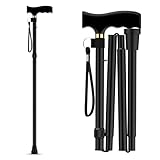Key Takeaways For Crutches vs Walking Sticks (Walking Canes)
Crutches: Provide significant support and balance for lower limb injuries or surgeries. Require both arms for upper body engagement and strength. Suited for short-term use during recovery, indoors and outdoors.
Walking Sticks (Canes): Offer stability for mild to moderate mobility issues. Designed for single-handed use, less intrusive than crutches. Suitable for long-term daily use, both indoors and outdoors.
Considerations: Choice depends on individual’s condition, mobility level, and duration. Crutches for substantial support in severe mobility limitations. Crutches for temporary use; walking sticks for long-term or chronic support.
Top Crutches
Top Walking Sticks
Crutches and walking sticks, or canes, are essential mobility aids for individuals with varying mobility challenges. Although both aids aim to enhance mobility, crutches and walking sticks serve different purposes and have unique features. In this comparison, we will explore the differences between crutches and walking sticks to assist you in making informed choices that best suit your needs.
Crutches
Support and Balance
Crutches are typically used when an individual needs significant support and balance assistance while walking. They are often prescribed for those with lower limb injuries, surgeries, or disabilities that require reduced weight-bearing on one or both legs.
Upper Body Engagement
Crutches require the use of both arms for support. Users place the crutches under their arms and use them to help lift their body weight, allowing them to take pressure off the lower limbs.
Operational Effort
Using crutches can be physically demanding, requiring upper body strength and coordination. Users need to maintain balance while walking and may need to possess good arm strength for stability.
Temporary Use
Crutches are typically used during recovery from injuries or medical procedures and are meant for short-term or temporary mobility limitations.
Indoor and Outdoor Use
Crutches are suitable for both indoor and outdoor use. Some models are designed for different terrains, such as rough outdoor surfaces.
Walking Sticks (Canes)
Stability and Balance Aid
Walking sticks, or canes, provide extra stability and balance support, primarily for individuals with mild to moderate mobility issues. They are often recommended for older people or those with minor walking difficulties.
Single-Handed Use
Canes are designed to be used with one hand, offering support on one side while the other hand remains free. They are a less intrusive mobility aid compared to crutches.
Operational Effort
Walking sticks require less effort and coordination compared to crutches. Users typically need less upper body strength and can rely on the cane for balance and support while walking.
Long-Term and Daily Use
Canes can be used long-term and for daily mobility needs. They are not restricted to short-term use during recovery.
Indoor and Outdoor Use
Canes are suitable for both indoor and outdoor use. However, they may need to be more stable on uneven terrain than crutches.
Considerations
User Condition
The choice between crutches and a walking stick depends on the individual’s specific condition, the level of mobility impairment, and the duration of assistance needed.
Safety and Stability
Crutches offer more substantial support and weight-bearing assistance than walking sticks, making them suitable for more severe mobility limitations.
Duration of Use
Crutches are typically used for temporary mobility limitations, while walking sticks are often employed for long-term or chronic mobility support.
Summary Of Crutches Vs Walking Stick
In summary, the decision between crutches and a walking stick should be based on the individual’s specific mobility requirements, the duration of assistance needed, and the level of support and balance necessary during walking. Healthcare professionals can provide valuable guidance in determining the most appropriate mobility aid for each person’s unique circumstances.
Top Crutches
Top Walking Sticks
Explore More Mobility Aid Options: Crutches vs. Walking Sticks
- Best Crutches for Support and Comfort – Discover the best crutches that provide optimal support and comfort for individuals with mobility challenges.
- Best Walking Sticks for Stability – Learn about walking sticks designed to offer stability and assist with balance for people with mild mobility impairments.
- How to Choose the Right Mobility Aid – Get guidance on selecting the most suitable mobility aid based on your specific needs and lifestyle.
- Crutches vs. Walking Frames: Which One is Right for You – Compare crutches and walking frames to determine which aid best suits your mobility requirements.

















